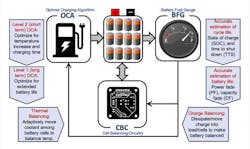Managing Tomorrow’s EV Batteries
This article is part of the TechXchange: EV Battery Management.
Members can download this article in PDF format.
What you'll learn:
- What functions does a typical battery-management system perform?
- The role of OCV in determining state of charge.
- Different approaches for better BMS accuracy.
- Handling a BMS's state of health.
Although battery-management systems (BMS) don't get much attention, modern electric vehicles (EVs) would not be possible without them. Tucked away inside every EV's battery pack there’s a BMS that’s responsible for insuring the safety and longevity of their powerful, but temperamental, cells.
Now, as EVs enter the mainstream market, both their batteries and the BMS technologies they rely on must evolve to meet the market's growing expectations for improved price, performance, and reliability. In this article, we'll discuss a few of the most significant issues driving the evolution of EV batteries, and how tomorrow’s BMS will help address them.
BMS Functionality
A typical BMS (Fig. 1) consists of four functional elements:
- Battery fuel gauge (BFG): Responsible for providing a real-time estimate of the battery pack's state of charge (SoC) and state of health (SoH) based on three values measured in real-time: voltage, current, and temperature.
- Optimal charging algorithms (OCAs): Responsible for controlling the charge current to optimize charging time while minimizing waste-heat production and preserving the battery's state of health.
- Cell balancing circuitry (CBC): Responsible for equalizing the voltage between the battery pack's individual cells. Many CBCs also monitor and balance cell temperatures.
- Health monitoring and protection: Although not specifically identified in the figure, a BMS also contains circuitry to monitor and protect against overtemperature/overcurrent conditions or physical damage to the battery pack.
Driving Issues
Tomorrow's battery packs will need to charge faster and deliver more of their total capacity without degrading their expected service life. This will require the BMS to provide much more accurate measurement and estimation of several critical parameters.
Perhaps the most important of these parameters is SoC. This is in part due to the fact that an accurate SoC value is essential for determining several other important values related to battery management. This includes the CBC and OCA functions, as well as monitoring the battery's state of health (SoH).
Estimating a battery's SoC is difficult because its actual capacity is constantly in flux, subject to the whims of the nonlinear electrochemical reactions occurring within it, as well as external factors such as temperature, usage patterns, and aging that act upon them. Due to these inaccuracies, today's BMSs must deliberately underestimate the actual amount of power remaining in the cells to prevent unexpected range shortfalls. This "stranded capacity" reduces the EV's useful range and/or adds unnecessary cost to its sticker price.
BMS evolution also is being driven by the need to ensure safety and longevity under the increasingly elevated currents and voltages being used in the next generation of EVs. Unless properly managed, higher current levels can increase the possibility of thermal runaway, as well as shorten the number of cycles the battery can deliver.
As a result, BMS algorithms must satisfy multiple, and occasionally contradictory, objectives. They must employ charging algorithms that strike a balance between the need to charge quickly and the need to minimize factors that contribute to cell degradation, such as the amount of heat waste produced during the charge cycle. In addition, optimizing the battery's charging profile requires improved methods for determining the battery's SoH.
How Full? How Healthy?
The two most common methods of estimating a battery's state of charge involve monitoring its open-circuit output voltage (OCV) or counting the number of electrons flowing in and out of it (aka coulomb counting). In theory, directly measuring a battery pack's OCV can provide accurate information about its SoC.2 Unfortunately, this simple technique is impractical in the real world because any current draw from the battery pack affects its output voltage and the cells can take several hours to return to their maximum state.
While the vehicle is operational, a useful but less precise value for the OCV can be obtained based on an electrical equivalent circuit model (ECM) of the battery or, in some cases, an electrochemical model. Once the OCV is estimated, the SoC can be derived from a lookup table of OCV-SoC characterization parameters. In either case however, the OCV estimates they produce are only as accurate the ECM model that’s used.
Fusion and Cloud Approaches
The ECMs currently used by commercial BMS suffer from limited accuracy, especially at the extremes of the battery's current range. Among the many promising approaches to more accurate modeling is a technique that uses a weighted least squares algorithm. It models hysteresis values as an error in the open circuit voltage (OCV) and compensates for it using a combination of real-time, linear parameter estimation and SoC tracking techniques (Fig. 2).1
Coulomb counting allows the BMS to directly measure current flow but presents its own challenges, due to imperfect knowledge of the battery's actual capacity, which varies according to manufacturing variations, temperature, usage patterns, and aging effects. These errors are compounded by inaccuracies and sampling errors introduced by the current-sensing electronics.
Many BMS designs improve their accuracy by using a fusion-based approach to determining SoC, which combines OCV estimation and coulomb-counting techniques. Typically, this involves a model that uses recursive Bayesian estimation and nonlinear filtering techniques to update its values and parameters in real-time as its predictions are compared against the battery's measured behavior.2
Fusion-based SoC estimation is already helping EVs provide drivers with more useful range estimates, but today’s BMS systems are still based on techniques and algorithms that have surprisingly high levels of uncertainty. This will begin to change in the near future as more accurate, noise-resistant sensors, and new techniques for obtaining more accurate OCV parameters, battery capacity, and ECM parameters find their way into commercial products.
The next generation of BMS also may make use of a secure cloud application that contains its battery's performance history, as well as the history of all similar battery packs. A cloud-assisted BMS (Fig. 3) will be able to collect data from an entire fleet of batteries and use it to more accurately estimate the parameters needed to manage its own battery pack.
State of Health
A battery's state of health is a more complex metric that’s based on the battery’s capacity, age, and wear level. This multi-variable parameter provides important information that can be used to adjust the battery's charging profile and other BMS functions for optimum performance and longevity.
While some details of the process may vary between different BMSs, their estimation of the battery's SoH is usually based on measurements of several related physical characteristics and service-related statistics.3
Counting the number of charge/discharge cycles can provide a good first-order estimate of how far along it is in the aging process. But this method doesn’t account for how deeply the battery was discharged, or if it was fully "topped up" on a particular charge cycle. It also doesn’t account for other factors, such as extreme temperatures and above-normal charge/discharge currents that can accelerate the aging process.
Modern BMSs are beginning to use some, or all, of these statistics into their SoH estimation process, but there’s another method of observing their collective effect on the battery's life.
A battery's decline in capacity and charge/discharge is primarily due to the increase in its internal resistance that occurs as it ages. In an ideal world, the pack's internal resistance could be calculated by measuring the difference between its OCV and its output voltage when connected with a known load.
In the real world, though, the BMS must rely on an estimated OCV value and a load value derived from its current sensors. Internal resistance also can be estimated using Joule’s law by measuring the energy generated by the battery during operation. In addition, some of the metrics used to determine SoC, such as coulomb counting and Kalman filtering, can help further refine the estimate.3,4
Read more articles in the TechXchange: EV Battery Management.
References
1. Balakumar Balasingam; Ahmed, Mostafa; Pattipati, Krishna. “Battery Management Systems—Challenges and Some Solutions,” Energies; Basel Vol. 13, Iss. 11, (2020).
2. B. Balasingam, G.V. Avvari, B. Pattipati, K.R. Pattipati, Y. Bar-Shalom. “A robust approach to battery fuel gauging, part I: Real time model identification,” Journal of Power Sources, Vol. 272, 25 December 2014, pp. 1142-1153.
3. Andrey Solovev, Anna Petrova. “Battery Management System (BMS): Effective Ways to Measure State-of-Charge and State-of-Health,” Integra Sources, September 2021.
4. Chris Murphy. "Expanding Functionality of Cell Supervision Unit in Battery Management Systems," Texas Instruments, September 2021.
About the Author
Lee Goldberg
Contributing Editor
Lee Goldberg is a self-identified “Recovering Engineer,” Maker/Hacker, Green-Tech Maven, Aviator, Gadfly, and Geek Dad. He spent the first 18 years of his career helping design microprocessors, embedded systems, renewable energy applications, and the occasional interplanetary spacecraft. After trading his ‘scope and soldering iron for a keyboard and a second career as a tech journalist, he’s spent the next two decades at several print and online engineering publications.
Lee’s current focus is power electronics, especially the technologies involved with energy efficiency, energy management, and renewable energy. This dovetails with his coverage of sustainable technologies and various environmental and social issues within the engineering community that he began in 1996. Lee also covers 3D printers, open-source hardware, and other Maker/Hacker technologies.
Lee holds a BSEE in Electrical Engineering from Thomas Edison College, and participated in a colloquium on technology, society, and the environment at Goddard College’s Institute for Social Ecology. His book, “Green Electronics/Green Bottom Line - A Commonsense Guide To Environmentally Responsible Engineering and Management,” was published by Newnes Press.
Lee, his wife Catherine, and his daughter Anwyn currently reside in the outskirts of Princeton N.J., where they masquerade as a typical suburban family.
Lee also writes the regular PowerBites series.




